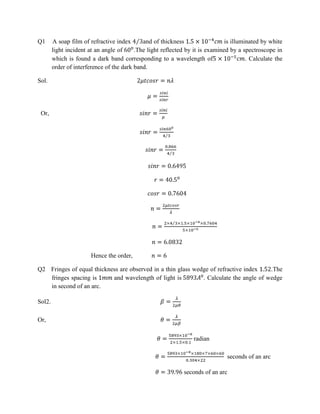
Optics
- 1. Q1 A soap film of refractive index and of thickness is illuminated by white light incident at an angle of .The light reflected by it is examined by a spectroscope in which is found a dark band corresponding to a wavelength of . Calculate the order of interference of the dark band. Sol. Or, Hence the order, Q2 Fringes of equal thickness are observed in a thin glass wedge of refractive index .The fringes spacing is and wavelength of light is . Calculate the angle of wedge in second of an arc. Sol2. Or, radian seconds of an arc seconds of an arc
- 2. Q3. In a Newton’s ring arrangement, if a plano-convex lens of radius is placed on an optically flat glass plate and is illuminated by monochromatic light .The diameter of the dark ring in the transmitted system is Calculate the wavelrngth of light used. Sol3. For the transmitted system Or Q4. Newton’s rings are formed by reflected light of wavelength with a liquid between th the plane and curved surfaces. If the diameter of 5 bright ring is 3mm and the radius of curvature of the curved surface is 100 cm. Calculate the refractive index of the liquid. Sol. Here for the nth bright ring, Q5 In Fraunhofer diffraction due to a narrow slit a screen is placed 2m away from the lens to obtain the pattern .If the slit width is 0.2mm and the first minima lie 5mm on either side of the central maxima, find the wavelength of light. Sol. So =
- 3. cm Q6 Deduce the missing order of the double slit Fraunhofer diffraction pattern if the slit width are 0.16mm and they are 0.8mm apart. Sol6. The direction of interference maxima are given by the eq. The direction of diffraction minima are given by For etc. etc. Thus the order 6, 12,18etc. of the interference maxima will be missing in the diffraction pattern. Q7. What is the highest order spectrum, which may be seen with monochromatic light of wavelength by means of a diffraction grating with 5000 lines/cm. Sol7. Here The maximum possible value of Here cm
- 4. So, The highest order of spectrum that can be seen is 3. Q8. In a plane transmission grating the angle of diffraction for the second order principal maxima for wavelength cm is . Calculate the number of lines in one cm of the grating surface. Sol8. cm Number of lines per cm=N’ Q.9 What should be the minimum number of lines in a grating which will just resolve in the second order the lines whose wavelength are and . Sol9. Resolving power Approximately. Q10.Calculate the minimum number of lines per cm in a 2.5 cm wide grating which will just resolve the sodium lines ( and in the second order spectrum. Sol10. Let the total number of lines required on the grating be N.
- 5. Number of lines per cm Q11. If the plane of vibration of the incident beam makes an angle of with the optic axis, compare the intensities of ordinary and extraordinary light. Sol11. Intensities of extraordinary ray Intensities of ordinary ray Q13. The angle of incidence of a light beam in air onto a reflecting surface is continuously variable. The reflected ray is found to be completely polarized when the angle of incidence is48.0°. (a) What is the index of refraction of the reflecting material? (b) If some of the incident light (at an angle of 48°) passes into the material below the surface, what is the angle of refraction? Sol13. (a) From Brewster’s law, the index of refraction is
- 6. (b) From Snell’s law, When Note that when , as it should. Q15. A glass wedge of angle 0.01 radian is illuminated by monochromatic light of falling normally on it. At what distance from the edge of the wedge, will be 10 th fringes be observed by reflected light. Sol15 But So Or = = cm.